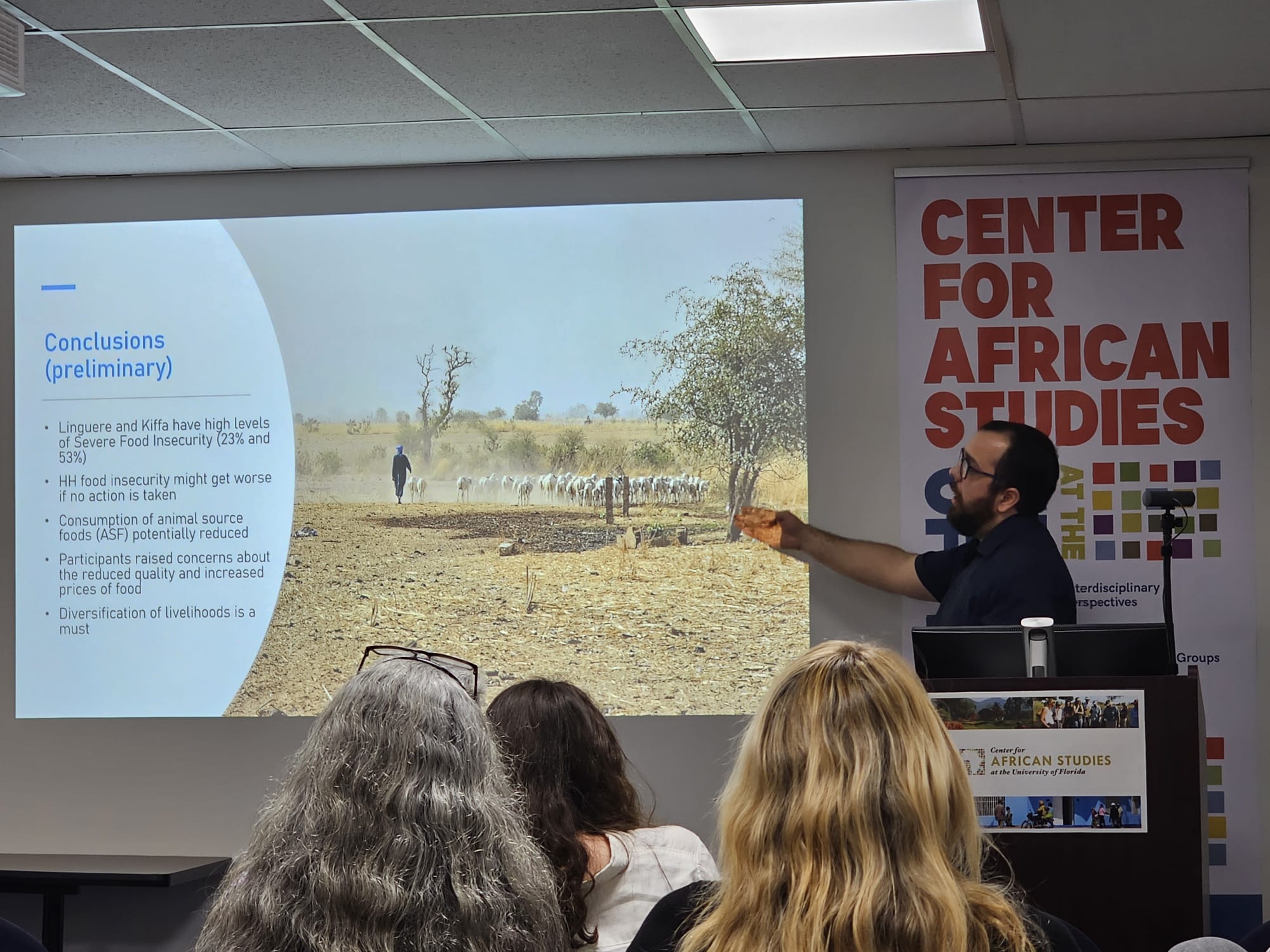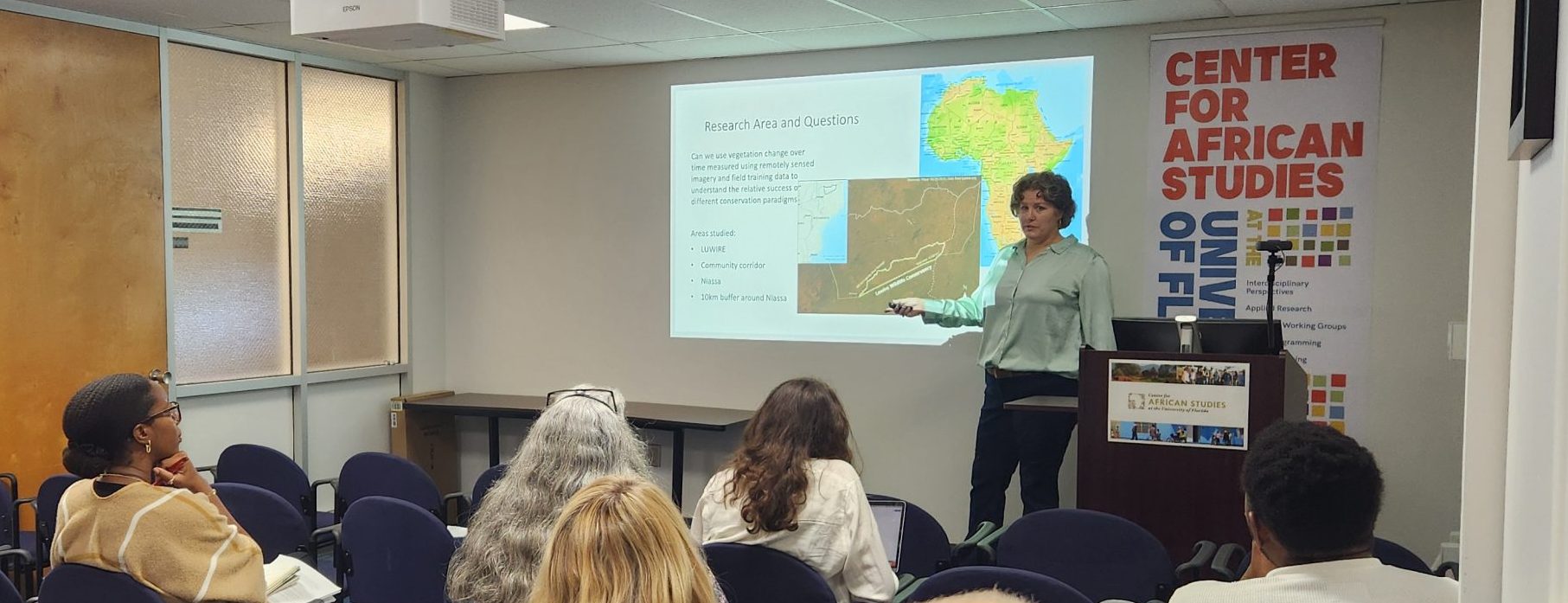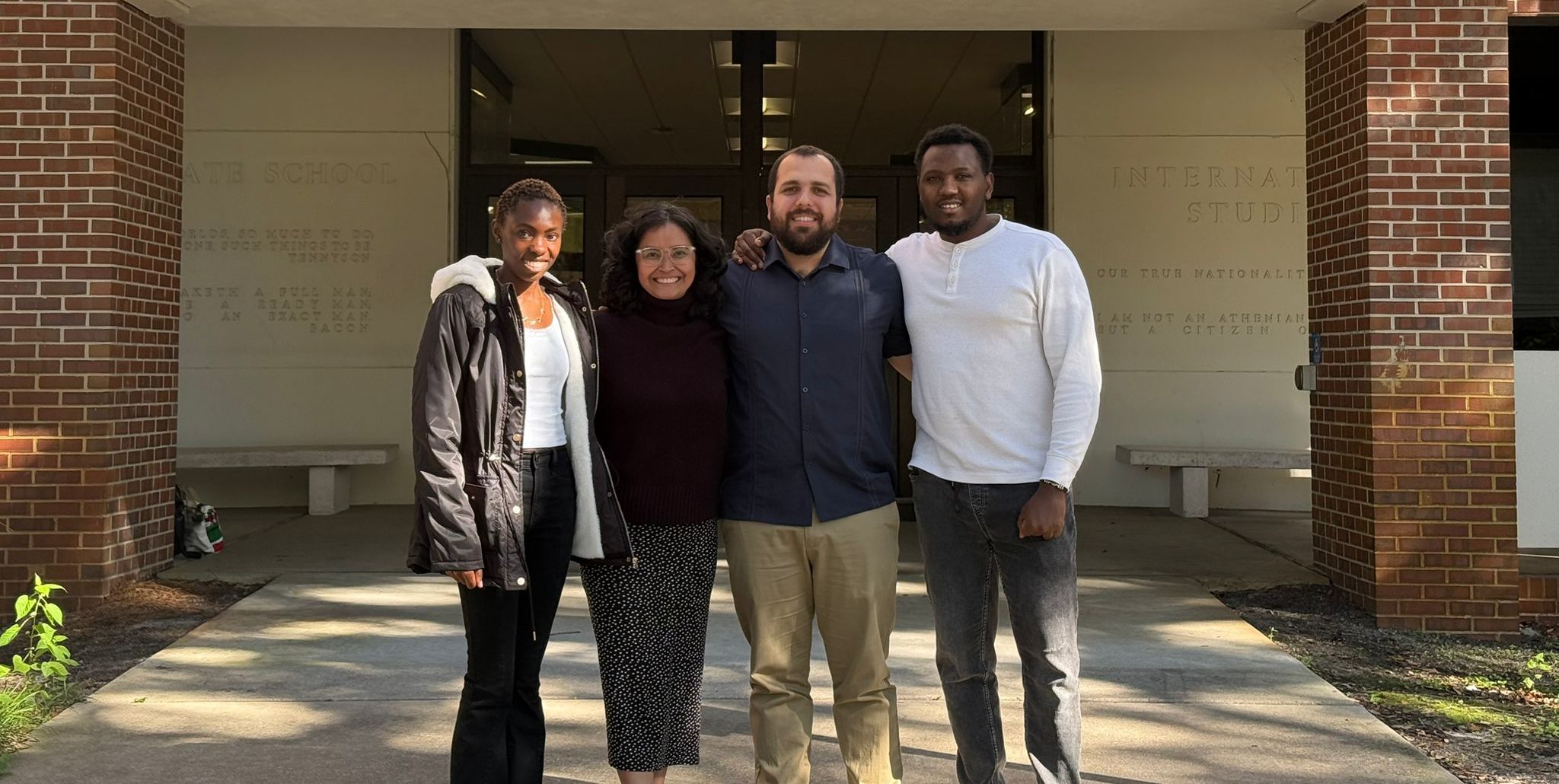The Center for African Studies recently hosted its first interdisciplinary graduate workshop “The Environment in Africa,” that invited graduate researchers, faculty, and attendees to explore critical environmental issues across the continent. The event featured student presentations on diverse topics, including climate change, conservation, public health, and gender dynamics in fisheries.
Joshua Benjamin explored macroinvertebrate shifts in a tropical river to inform biomonitoring strategies. Daniel Acosta examined the impacts of climate change on food and nutritional security in the Sahel. Michael Mathelier presented on telemedicine applications in malaria-endemic regions, and Jessica Striley analyzed land cover changes in Mozambique’s Lugenda Wildlife Reserve for conservation planning.
During the afternoon session, Sylvia Adisa discussed gender roles in artisanal billfish fisheries in the Western Indian Ocean. Mackenzie Connell reported on pesticide monitoring in Ethiopia’s Oromia region, and Fevi Rose Paro mapped environmental variations linked to child malnutrition in Rwanda.
The workshop also included a lunch discussion, where faculty provided insights on interdisciplinary research methods and collaboration with local communities. This event showcased UF graduate students’ innovative approaches to environmental research, highlighting the Center’s commitment to increasing understanding and solutions for global challenges.
Students’ Research Abstracts:
Joshua M. Benjamin
Spatial and Temporal shifts: A decade of macroinvertebrate assemblage in a tropical river and the implication in biomonitoring
Benthic macroinvertebrates have long been used as bioindicators of water quality in aquatic systems. Despite their essential role in freshwater ecosystems, they face threats from anthropogenic stressors such as land use, pollution, and climate change effects. This study investigates community composition changes along the Mara River’s gradient over time, using survey data from 2008-09 and 2022-23. We aim to track macroinvertebrate changes over the past 15 years, document macroinvertebrate composition and diversity, and identify critical ecological variables influencing macroinvertebrate assemblages. We observed significant taxonomic shifts between historical and current compositions in the Mara River. Moreover, macroinvertebrate diversity varied along the river gradient, with the highest diversity upstream, followed by the middle reach, and the lowest downstream. Water velocity, elevation, temperature, nitrate concentration, and dissolved oxygen impact macroinvertebrate diversity in the Mara River Basin. These findings highlight the importance of macroinvertebrates as indicators of freshwater ecosystem health and support the need for conservation strategies to protect these complex aquatic communities.
Daniel Acosta
Climate change in the Sahel: Impacts on food and nutritional security
 Climate change poses a significant threat to global food systems, particularly in the Sahel, where reliance on rainfed agriculture makes the region especially vulnerable. This study focuses on the social and institutional resilience elements in the context of climate change. Data were collected through surveys, semi-structured interviews, and a photovoice session in each site from January to June 2024 in Linguere, Senegal, and Kiffa, Mauritania. Results indicate climate hazards, such as floods and droughts, were highlighted as major concerns impacting human and animal health, access to veterinary supplies, and the quality of food. High levels of food insecurity were found in the study sites. Livestock emerged as a crucial asset for food security. Households with diversified income strategies had better food security and dietary diversity. The study underscores the importance of increasing access to veterinary services and promoting resilience programs, such as micro-financing and designated pastoral zones, to enhance agro-pastoral systems’ resilience in the Sahel.
Climate change poses a significant threat to global food systems, particularly in the Sahel, where reliance on rainfed agriculture makes the region especially vulnerable. This study focuses on the social and institutional resilience elements in the context of climate change. Data were collected through surveys, semi-structured interviews, and a photovoice session in each site from January to June 2024 in Linguere, Senegal, and Kiffa, Mauritania. Results indicate climate hazards, such as floods and droughts, were highlighted as major concerns impacting human and animal health, access to veterinary supplies, and the quality of food. High levels of food insecurity were found in the study sites. Livestock emerged as a crucial asset for food security. Households with diversified income strategies had better food security and dietary diversity. The study underscores the importance of increasing access to veterinary services and promoting resilience programs, such as micro-financing and designated pastoral zones, to enhance agro-pastoral systems’ resilience in the Sahel.
Michael Mathelier
Applying the ADAPT guidance to implement a telemedicine and medication delivery service in a malaria-endemic setting: a prospective cohort study
Implementing evidence-informed interventions in new contexts requires adaptations to ensure effectiveness. This study aimed to adapt, implement, and evaluate a pediatric nighttime Telemedicine and Medication Delivery Service (TMDS) from Haiti to Ghana, following the ADAPT guidance model. Adaptations included changes in clinician type, user fees, and the addition of malaria rapid diagnostic testing. A 12-month prospective cohort study was conducted in Accra, Ghana, to assess clinical safety and operational feasibility. Out of 492 cases enrolled, 91% received in-person assessments, and 96% had follow-up at 10 days. The intervention met predefined safety and feasibility metrics, with no severe adverse events reported. However, the study highlighted limited congruence between telemedicine and in-person assessments, suggesting the need for a streamlined telemedicine approach. The TMDS model was deemed safe and feasible for use in malaria-endemic settings, though further studies are needed to optimize and scale the intervention.
Jessica L. Striley
Land Cover Change in Lugenda Wildlife Reserve, Niassa, Mozambique for Conservation Assessment and Planning

Niassa Special Reserve is a Mozambican protected area approximately the size of Switzerland, and one of the largest remaining intact miombo woodlands. Lugenda Wildlife Reserve (LUWIRE) is a 4550 km2 block leased and operated as a safari for hunting and adventure tourism. Nine communities containing ~5000 people within the block contribute both to landscape destruction and conservation success. LUWIRE runs anti-poaching patrols and community development programs. Understanding the effects of these conservation efforts and land use patterns on land cover would enable better planning and possibly new funding. Using 500 training points collected in LUWIRE this summer, supervised classification of land cover types was conducted at 4 timesteps to analyze land cover change. Results indicate an increase in forest cover, particularly between 2013 and 2018. This corresponds to a slight increase shown in 10-year annual mean NDVI data from Landsat 8. Local interviews also indicated an increase in vegetation cover, particularly trees. Immediate next steps are to incorporate additional ecological data from ground surveying, determine where land cover has changed the most, and to compare LUWIRE cover to that outside the reserve and in other adjacent blocks within Niassa. Other work will incorporate social variables to understand drivers of changes.
Sylvia Adisa
Men and women in artisanal billfish fisheries in the Western Indian Ocean region (WIO): Roles, challenges and opportunities
To understand the gender dynamics in fisheries, it is essential to examine the participation of both men and women in the sector. However, there is limited data regarding women’s involvement in billfish fisheries globally. As a result, it is challenging to accurately recognize, acknowledge, or estimate the extent of women’s participation, perspectives, and contributions, which results in their limited presence in billfish scholarship and policy decision-making.
To address this knowledge gap, this study focuses on women’s roles and participation in artisanal billfish fisheries value chains in the Western Indian Ocean (WIO) region using Kenya’s coast as a case study. Our findings show that while women’s contributions to billfish fisheries are limited, they are actively involved as consistent buyers, creating a market for fishers and bridging the gap between producers and consumers in artisanal billfish fisheries. The roles of men and women in the sector are influenced by sociocultural factors, which shape how they engage in different roles.
This study illuminates the different challenges and opportunities faced by men and women in Kenya’s artisanal fisheries. By highlighting the specific needs of men and women in billfish fisheries, our study lays a crucial foundation for policymaking and efforts toward gender equality and sustainable billfish fisheries.
Fevi Rose Paro
Mapping Malnutrition: Exploring environmental variations associated with child malnutrition in Rwanda
 Malnutrition remains unacceptably high in Rwanda despite its continuous nutrition efforts. Various studies have shown that factors like child birthweight, maternal education, including wealth index and access to water and sanitation, are key determinants to malnutrition in the country. Limited research, however, have explored environmental variations that impact undernutrition rates (stunting, wasting and underweight) in Rwanda. This study aims to determine the association of elevation, aridity, precipitation, and livestock density (e.g. cattle, chicken, pig and goat) to undernutrition in children under 5 in Rwanda. Datasets were extracted from the Rwanda Demographic and Health Survey (DHS) 2019-2020 to build a spatial regression model. Preliminary findings show that spatial distributions of stunting, wasting and underweight vary with the density of livestock across districts. Livestock density per animal vary as well according to elevation, aridity, and precipitation in each province in Rwanda. Exploring these environmental predictors and its spatial distribution will allow us identify risk factors, high-risk sites, and optimal interventions to improve nutrition in the area.
Malnutrition remains unacceptably high in Rwanda despite its continuous nutrition efforts. Various studies have shown that factors like child birthweight, maternal education, including wealth index and access to water and sanitation, are key determinants to malnutrition in the country. Limited research, however, have explored environmental variations that impact undernutrition rates (stunting, wasting and underweight) in Rwanda. This study aims to determine the association of elevation, aridity, precipitation, and livestock density (e.g. cattle, chicken, pig and goat) to undernutrition in children under 5 in Rwanda. Datasets were extracted from the Rwanda Demographic and Health Survey (DHS) 2019-2020 to build a spatial regression model. Preliminary findings show that spatial distributions of stunting, wasting and underweight vary with the density of livestock across districts. Livestock density per animal vary as well according to elevation, aridity, and precipitation in each province in Rwanda. Exploring these environmental predictors and its spatial distribution will allow us identify risk factors, high-risk sites, and optimal interventions to improve nutrition in the area.
Mackenzie L. Connell
Monitoring of agricultural pesticides in surface and drinking water in the Oromia region of Ethiopia

Pesticides are relied upon in the agricultural sector globally and can heavily impact local and regional water resources. Many organophosphate and organochlorine-based pesticides are regulated or banned in high-resource countries. In many regions, especially the global south, these compounds protect livelihoods, and use is often loosely regulated. Environmental monitoring data showing the burden of pesticides is largely unreported especially in rural regions of Ethiopia and water-limited settings. To address this gap and contextualize the clinical observations and epidemiology research in the region, we conducted a pilot study to determine what pesticides were detectable in water samples in a high khat cultivation and export region. Grab samples (surface and drinking water) and leaf swabs were collected from an agricultural watershed in Ethiopia (Haramaya town) during the dry season. AMPA-SPE cartridges and HLB columns were used, and downstream analysis was performed with GC-MS/MS and LC-MS/MS. We detected 9 compounds out of 28 compounds of interest for the region. DDE was only detected in surface water. Diazinon, Fenitrothion, Atrazine, and gamma BHC were detected in all water samples. DDE and permethrin isomers were detected from gauze swabs of khat leaves. Findings suggest recent use of pesticides in this region- important for future studies focused on the human health effects of environmental exposures affecting early onset of disease. Further studies are required for full scale environmental monitoring of these compounds, especially in agricultural watersheds, to explore the link between pesticides and adverse health effects like cancer and birth defects.
*Please acknowledge the ATCL in any publications that use this data and please cite the shared instrumentation grant for the instrument, for example, “This project was made possible in part by a U.S. National Institutes of Health (NIH) Shared Instrumentation Grant (1S10OD018141)

